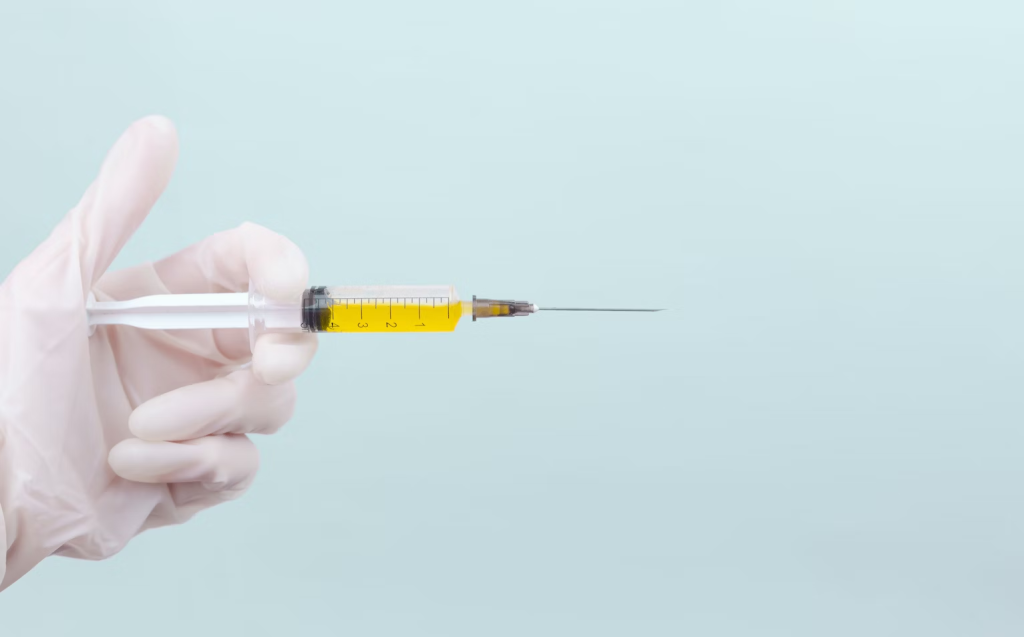In the realm of regenerative medicine, prolotherapy has emerged as a promising treatment option for musculoskeletal injuries and chronic pain conditions. Also known as “proliferative therapy” or “proliferation therapy,” this non-surgical procedure involves the injection of a solution into damaged or weakened ligaments, tendons, or joints.
The goal of prolotherapy is to stimulate the body’s natural healing process, thereby promoting tissue repair and reducing pain. In this article, we delve into the various applications and benefits of prolotherapy.

How Prolotherapy Works
Prolotherapy primarily operates on the principle of controlled inflammation. A specialized solution, typically containing a dextrose solution mixed with a local anesthetic, is injected directly into the affected area. This creates a mild irritation, stimulating the body’s immune response. Consequently, blood flow, nutrients, and growth factors rush to the area, jumpstarting the repair process.
Conditions Treated with Prolotherapy
- Chronic Pain: Prolotherapy is widely recognized for its efficacy in treating chronic pain conditions, such as osteoarthritis, fibromyalgia, and lower back pain. Targeting the source of the pain offers relief and improves overall functionality.
- Ligament and Tendon Injuries: Prolotherapy is particularly effective for injuries to ligaments and tendons. These structures have a limited blood supply, which can impede their natural healing process. Prolotherapy enhances blood flow and nutrient delivery to these areas, facilitating repair.
- Sports Injuries: Athletes often turn to prolotherapy for a swift and effective recovery from sports-related injuries, including sprains, strains, and joint instability. The treatment not only accelerates healing but also strengthens the affected structures.
- Degenerative Joint Diseases: Conditions like osteoarthritis and degenerative disc disease can cause considerable discomfort and mobility issues. Prolotherapy offers a non-invasive alternative to surgical interventions, providing relief and potentially slowing down the progression of these conditions.
- Muscle Pain and Spasms: Chronic muscle pain and spasms can significantly impact one’s quality of life. Prolotherapy can target trigger points, providing relief and restoring normal muscle function.
Advantages Of Prolotherapy
Non-Surgical and Minimally Invasive
One of the most significant advantages of prolotherapy is that it is a non-surgical procedure. This means no incisions, no general anesthesia, and reduced recovery time compared to surgical interventions. Additionally, the minimally invasive nature of prolotherapy lowers the risk of complications.
Targeted Treatment
Prolotherapy directly addresses the affected area, making it highly specific in its action. This precision ensures that the treatment focuses on the root cause of the pain or injury, rather than merely masking symptoms.
Stimulates Natural Healing
Rather than relying on external interventions, prolotherapy harnesses the body’s innate healing mechanisms. By promoting inflammation and subsequent repair, prolotherapy encourages the body to heal itself, resulting in long-lasting relief.
Versatile Application
Prolotherapy can be applied to various parts of the body, including the spine, shoulders, knees, and ankles. This versatility makes it a valuable option for a wide range of musculoskeletal conditions.
Complementary to Other Treatments
Prolotherapy can be used in conjunction with other therapies, such as physical therapy or chiropractic care. This multi-modal approach can enhance the overall effectiveness of treatment.
What to Expect During A Prolotherapy Session
Evaluation and Diagnosis
Before administering prolotherapy, a thorough assessment of the patient’s medical history, physical condition, and imaging studies (if applicable) is conducted. This ensures that prolotherapy is the appropriate course of action.
Injection Procedure
During the procedure, the physician will use a fine needle to deliver the prolotherapy solution to the targeted area. The patient may experience mild discomfort, but this is typically well-tolerated.
Post-Treatment Care
Following the procedure, patients may experience some soreness and swelling, which is a natural part of the healing process. Rest and avoiding strenuous activities for a short period may be recommended.
What Is The Success Rate Of Prolotherapy?
The success rate of prolotherapy can vary depending on several factors, including the specific condition being treated, the expertise of the healthcare provider administering the treatment, and the individual patient’s response to the therapy. Research and clinical studies have shown a range of success rates for prolotherapy across different conditions:
- Chronic Pain Conditions: Prolotherapy has shown promising results in treating chronic pain conditions, with success rates ranging from 50% to 90% in various studies. Conditions like osteoarthritis, lower back pain, and musculoskeletal pain have shown positive responses to prolotherapy.
- Ligament and Tendon Injuries: Prolotherapy is considered highly effective for ligament and tendon injuries. Success rates for treating conditions like ligament laxity or tendinosis are often reported to be around 80% or higher.
- Sports Injuries: Athletes with sports-related injuries have reported significant improvement and a return to their activities after undergoing prolotherapy. Success rates for sports injuries can be particularly high, ranging from 70% to 90%.
- Degenerative Joint Diseases: Prolotherapy has shown positive outcomes in patients with degenerative joint diseases like osteoarthritis. Success rates vary, but many studies report notable improvements in pain levels, function, and quality of life.
- Muscle Pain and Spasms: Prolotherapy can effectively target trigger points and alleviate muscle pain and spasms. Success rates in treating muscle-related issues are generally high, with many patients experiencing significant relief.
It’s important to note that while these success rates are based on clinical studies and real-world experiences, individual results may vary. Some patients may experience complete resolution of their symptoms, while others may experience partial relief or require additional treatments.
Additionally, the skill and experience of the healthcare provider administering prolotherapy play a crucial role in its success. A qualified and experienced practitioner is more likely to achieve positive outcomes.
As with any medical treatment, it’s essential for patients to have realistic expectations and to communicate openly with their healthcare provider about their progress and any concerns they may have. This allows for adjustments in the treatment plan if necessary, ensuring the best possible outcome.
What Are The Risks Of Prolotherapy?
While prolotherapy is generally considered safe, like any medical procedure, it does carry some potential risks and considerations. It’s important for individuals considering prolotherapy to discuss these with their healthcare provider before undergoing the treatment. Here are some of the potential risks associated with prolotherapy:
- Pain and Discomfort: After a prolotherapy session, it’s common to experience some level of pain, swelling, and discomfort at the injection site. This is typically temporary and is part of the natural healing response.
- Bruising and Swelling: There may be some bruising or swelling at the injection site. This is usually mild and should subside within a few days.
- Infection: While infection is rare, there is a small risk associated with any injection-based procedure. Proper sterile techniques and a clean environment can significantly reduce this risk.
- Allergic Reaction: Although extremely uncommon, there is a possibility of an allergic reaction to the solution used in prolotherapy. Patients need to inform their healthcare provider of any known allergies before the procedure.
- Nerve Damage: While rare, there is a small risk of nerve damage associated with any injection-based procedure. This risk is minimized when the procedure is performed by a skilled and experienced healthcare provider.
- Post-Injection Pain Syndrome: In some cases, patients may experience an increase in pain after the prolotherapy session. This is usually temporary and is part of the body’s healing response.
- Failure to Provide Relief: While prolotherapy can be highly effective, it may not provide complete relief for all patients or all types of conditions. It’s important for patients to have realistic expectations and to communicate openly with their healthcare provider about their progress.
- Unintended Tissue Damage: While prolotherapy is intended to stimulate healing, there is a theoretical risk of unintended tissue damage if the injection is not properly administered.
- Adverse Reaction to Anesthetic: If a local anesthetic is used in conjunction with the prolotherapy solution, there is a small risk of an adverse reaction to the anesthetic.
It’s crucial for individuals considering prolotherapy to consult with a qualified and experienced healthcare provider. They can provide a thorough evaluation, discuss the potential risks and benefits, and address any concerns the patient may have. Additionally, patients should disclose their complete medical history, including any allergies or previous adverse reactions to injections, to ensure the procedure is safe for them.
Conclusion
Prolotherapy offers a promising avenue for individuals seeking relief from chronic pain and musculoskeletal injuries. By harnessing the body’s natural healing abilities, this non-surgical procedure provides targeted and long-lasting benefits. From athletes recovering from sports injuries to individuals struggling with degenerative joint conditions, prolotherapy presents a versatile and effective treatment option.
As with any medical procedure, it is crucial to consult with a qualified healthcare provider to determine if prolotherapy is the right choice for your specific condition.
Read more about prolotherapy by clicking prolotherapy Melbourne.
